You never quite know where your research is going to take you, but I have to admit I didn’t expect it to be to the Isle of Wight. That, however, is where I ended up a couple of months ago as a result of my Russians in London post on Alexander Herzen, after I was contacted by Bob and Esme Williamson, owners of St Augustine Villa, a charming hotel on the Esplanade in Ventnor, and probably the most distinctive building in the town.
Whilst researching the history of hotel, which was built in 1846 by the Reverend Richard John Shutte (1800-1860), who had earlier been a canon at St Paul’s Cathedral and by 1855 was rector at Halden, Kent, the owners discovered that Herzen and his family had rented the house – then barely ten years old – during their stay in September 1855.
The Williamsons learned about Herzen’s stay when they were contacted by a Dutch researcher at the International Institute of Social History in Amsterdam, who had made a remarkable discovery whilst looking through Thomas Carlyle’s letters to Herzen in the Institute’s archives. Among the Herzen papers, there were several drawings, by an unknown hand, and depicting unknown scenes. By an extraordinary coincidence, the researcher had spent time in Ventnor as an au pair in the 1960s, and she recognized two of the pictures as being of St Augustine Villa:
The others are of the coast around Ventnor. It was easy to establish that Herzen stayed at the house – two of the letters he sent from Ventnor in 1855 are addressed ‘St Augustins Villas’ (the inaccuracy is fairly typical). But the authorship of the drawings was much initially less certain. It seemed unlikely that Herzen himself would have drawn them – his sketch-maps and the other little doodles that appear in his letters are distinctly amateurish, and in any case one rather suspects he would have viewed art as something of a distraction (his letters overall reveal a man consumed with work and family life, with little time or inclination for other pursuits). There was a suggestion that his son Sasha might have been responsible, but it soon became apparent that there was a trained artist in their entourage: Malwida von Meysenbug (see her Memoirs of an Idealist, pp. 44-46).
Comparing the sketches of Ventnor to pictures by von Meysenbug in Vera Leuschner’s book, Malwida von Meysenbug: Die Malerei war immer meine liebste Kunst [Painting has always been my favourite art], leaves one in no doubt; the style is so similar that the pictures must be hers.
This, incidentally, is why I was so disgusted with E. H. Carr (see my previous post): Malwida von Meysenbug was a talented artist and writer, and he reduces her to an unutilized (ergo, hysterical) womb. One knows only too well the extent to which women’s achievements have been denigrated or ignored, and Carr was hardly the only guilty party, but it does feel particularly offensive when it’s being done right in front of your eyes. It’s also very unfortunate that Tom Stoppard’s characterization of von Meysenbug in Salvage, the final part of his Coast of Utopia trilogy, seems based entirely on Carr’s opinion; her art, as far as I could see, is never mentioned, and she does not step beyond her role as governess and surrogate mother. Anyway, I’ve already said my piece on that subject, so back to today’s topic.
So off we went to Ventnor to follow in Herzen’s footsteps and stay at St Augustine Villa. And I can only recommend that you, dear reader, do the same. The hotel is lovely, and in a fabulous position, as the pictures show. Bob and Esme are very welcoming hosts, and provide excellent (and enormous) breakfasts (be warned – you won’t want much lunch). It was really interesting thinking about Herzen, von Meysenbug and the children staying there, and imagining how they spent their time. Although he doubtless spent a lot of time in the house working (what precisely he was working on while he was there I have yet to establish), I conjured up an entirely fanciful and anachronistic picture of Herzen strolling down the Esplanade eating an ice cream (probably because of the very memorable Minghella’s blackcurrant and cream ice cream I sampled) and having a pint in the Spyglass Inn. We spent a lot of time looking at old photographs of Ventnor – which is a really interesting place – and working out what has changed, mainly due to reconstruction after the war, in order to get an idea of what it was like in the mid-nineteenth century.
So what do we know about the family’s stay there? To be honest, not a huge amount, because the letters are concerned, as usually, overwhelmingly with Herzen’s work and domestic arrangements. There were in fact two trips to the town. The first, at the end of September 1854, lasted around a week. So far, I’ve not managed to find out where they stayed, but it’s clear that Herzen was as taken with Ventnor as we were; in the one letter he wrote during this visit, to his regular correspondent Maria Reichel, on 28th September, he comments, ‘this is an amazing place, i.e., one never expected to find such charms in England.’ (Sobranie sochinenii v 30-i tomakh, 25, p. 202) Von Meysenbug expands slightly on this in her Memoirs:
[Herzen] proposed a small trip to the sea which I had previously suggested to him and which he had turned down.
So we left. Domengé came with us, and we took the boat over to Wight Island, the natural beauty of which I had long wanted to see. On the journey across the island to the little city of Ventnor on the southern side, Herzen, his son, and Domengé sat atop the stagecoach, the children and I sat inside. Delighted by the glorious road, I called up to them: ‘Isn’t that beautiful? Wasn’t I right in suggesting this?’ Laughingly, Herzen called down: ‘I didn’t want to tell you, but yes, you were right: its glorious and I’m glad we came.’
We spent happy days in beautiful Ventnor. In the evenings we were usually with the Pulszkys, who were spending the summer there. Therese’s mother, an educated and intelligent Viennese lady, had come to visit them, and this made for many a pleasant hour with her keen humor and wit. The Kossuths were also there, and he was much more pleasant in a more intimate setting than he had been at the formal gatherings in London. At the time, our thoughts were preoccupied by the war Russia had started with Turkey. Herzen, more so than the others, was very excited. He prophesied the Russian defeat and wished for it, since he believed it would lead to the downfall of autocracy. (pp. 222-3)
Von Meysenbug also, Herzen informs us, spent all her time in the water, presumably using a bathing machine like those in this photo from 1911:
probably hired from Blakes, providers of beach huts, deck chairs and the like since 1830 – an unexpected sign of continuity, and a strong indication of how established Ventnor was as a resort years before Herzen’s and Meysenbug’s visit.
No further details are given, and the rest of the letter is taken up with recipes for treating cholera, which was then raging in London – a stark reminder of the differences between life then and now, which are often easy to overlook.
The trip was clearly enjoyable enough to ensure a return the following year for a more extended stay. Again, von Meysenbug’s description is brief:
Herzen himself suggested that we again go to Ventnor on the Island of Wight for a few weeks. Of course, the children and I welcomed this suggestion. We rented a comfortable home on the ocean, and the wonderful sea air and charmingly beautiful coast revived our good spirits. The Pulszkys were also there again. They frequently came in the evening, and I enjoyed being together with Therese, whose sensitive personality became less of a mystery to me than it had been in the political excitement of London life. News reached us there about the taking of Malakoff. This meant that Sebastopols [sic] would probably fall and the war would be over. We rejoiced at the news, not only out of consideration for human life, but especially for Russia, since it could be assumed that the new emperor would attempt domestic reforms after the close of this war he had inherited. (pp. 240-1)
Herzen is even more sparing in his details. He writes to the Italian activist Luigi Pianciani on 8th September that Ventnor was chosen largely because of the cost of going to Jersey, their first idea, and because the children’s seasickness would have been a problem on the longer voyage (p. 299). The following day, a letter to Maria Reichel includes a note from Tata (Natalya), about her nameday party, which is, typically, somewhat more informative than her father’s missives:
Daddy gave me two wonderful books, «Die Völker des Erdballs» [The Peoples of the Globe] by von Burghaus, and there are wonderful pictures in them. Sasha gave me a little knife, Mselle Buch – a toy boat, oysters, and a scarf, Louisa – a glass basket, Olya had been saving a penny for a long time, and she bought me some chocolate by herself. (p. 300)
In his next letter to Reichel, dated 20th September, Herzen is slightly more forthcoming about his activities: ‘For three days the weather has been like June – and I’m bathing recklessly in the sea. But before that there were four days of storms, rain and bitter cold. […] The children are perfectly healthy. Tata and Olya bathe every day. Sasha, too.’ (p. 301) Some fondness for Ventnor is evident, but it’s tinged with his usual ambivalence about England as a whole: ‘If it were not so boring, I would live here, but there are no resources at all. And getting to Ryde is expensive. Another winter in England – it’s awful to contemplate. But where can we go?’ The complaints then take over; in another letter, dated 25th September, Herzen reports catching a cold (p. 302), and in his final letter from Ventnor to Reichel, he notes that the weather has recently been ‘dreadful’ (p. 304), while a postscript from Sasha to the same letter reads: ‘we’re already preparing to leave for Richmond; however, it’s quite boring here – the weather is awful, you go walk anywhere – and in that case it’s better to be at home’ – clearly he was his father’s son.
And that’s it. I’ll publish the translations in full in a separate post, but essentially they show the extent to which Herzen, even on holiday, was preoccupied with work, his household, and his business and domestic affairs back in London. He pays far less attention to his own present circumstances than those of his family and entourage elsewhere. A bit of bathing aside, there doesn’t seem to have been much to distinguish the holiday from his usual life, and given that a number of other exiles, such as the Hungarians Lajos Kossuth and Ferenc Pulszky, were in Ventnor at the same time, even his evening socializing must have very much resembled his normal London activity, discussing the Crimean war and the political situation in Russia. With Malwida von Meysenbug’s pictures we have a glimpse of another side of the visit, of walks along the beautiful coastal path and an appreciation of the landscape that seems to escape Herzen, his enthusiastic initial response to their first visit aside.
Although I appreciate Herzen very much as a writer, and admire his commitment, there are times when I wish he had been a bit more well-rounded. His lack of engagement with his surroundings means that for me at least he sometimes seems quite an elusive figure despite his copious memoirs and letters. A comparison with Turgenev, who visited Ventnor in 1860, reveals a much more concrete sense of the person in the place, because he responded to it as an artist; as both Freeborn (pp. 407-12) and Waddington (pp. 95-110) have shown, Ventnor played a significant role in the development of Turgenev’s idea for Fathers and Sons, and the nearby Blackgang Chine appears in the story Phantoms. This, I would suggest, is also why Turgenev’s visit to Ventnor has not only been fictionalized by Richard Freeborn in his novel The Russian Crucifix: A Victorian Mystery, but also features in Stoppard’s Salvage (pp. 303-8), whereas Herzen’s does not, despite his being the major focus of that play. In fact, his absence from the scene is emphasized because Malwida von Meysenbug and Olya Herzen are present, shrimping and collecting shells on the beach; it is they who notice Turgenev, talking to the doctor who supposedly becomes the model for Bazarov. (The Herzen family actually holidayed in Bournemouth that summer, apparently after Herzen realized that Ventnor was going to be overrun by Russians.) It suggests a figure who is curiously absent from parts of his own life.
Turgenev’s stay in Ventnor is commemorated in a local heritage museum plaque.
Herzen’s visit may not have left as much of a trace in his works, but with the identification of von Meysenbug’s drawings of Ventnor, I hope that their stay at St Augustine Villa will be similarly marked. Theirs was obviously an odd household, but whatever the personal shortcomings of the one and marginalization of the other by history, they were both figures of some distinction and importance.
My thanks to Bob and Esme Williamson for their hospitality, to Mieke Ijzermans, whose research contributed greatly to this post, and to John Levin for being a wonderful companion with whom to explore the area, and for his permission to use the photographs of Richard Shutte’s gravestone and Blakes’ deckchair hire. The photos of St Augustine Villa and of the Turgenev plaque are my own. Both my own and John Levin’s photographs, and the copies of the drawings by Malwida von Meysenbug, are licensed under a Creative Commons Attribution-No Derivative works 2.0 England and Wales License.
Sources
E. H. Carr, The Romantic Exiles: A Nineteenth-Century Portrait Gallery (London: Peregrine, 1968; first publ. 1933)
Carol Deithe, ‘Keeping Busy in the Waiting Room: German Women Writers in London following the 1848 Revolution, in Exiles from European Revolutions: refugees in mid-Victorian England, ed. Sabine Freitag (New York and Oxford: Berghahn, 2003), 253-74
Richard Freeborn, ‘Turgenev at Ventnor’, Slavonic and East European Review 51, no. 124 (July, 1973), 387-412
Richard Freeborn, The Russian Crucifix: A Victorian Mystery (London: McMillan, 1987)
A. I. Gertsen, Sobranie sochinenii v tridtsati tomakh. Tom dvadtsat’ piatyi: pis’ma 1853-1856 godov (Moscow: Nauka, 1961)
Vera Leuschner, Malwida von Meysenbug: Die Malerei war immer meine liebste Kunst (Bielefeld: Verlag fuer Regionalgeschichte, 2002)
Malwida von Mysenbug, Memoiren einer Idealistin (1869) | Memoirs of an Idealist, trans. Monte B. Gardiner (1999)
Tom Stoppard, The Coast of Utopia (London: Faber and Faber, 2008)
Patrick Waddington, Turgenev and England (Basingstoke: McMillan, 1980)

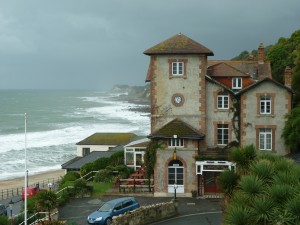
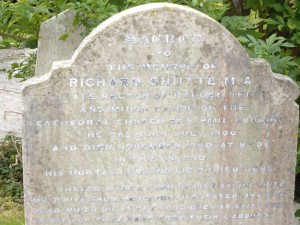
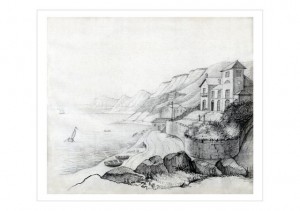
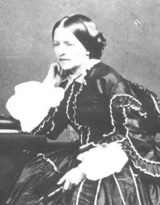
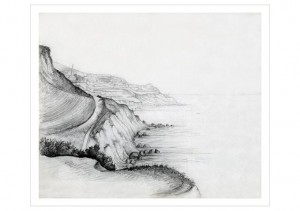

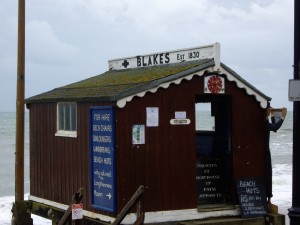
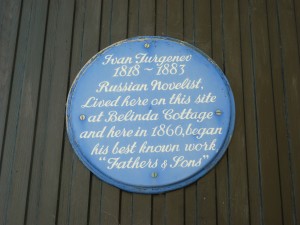
Judi Binks
/ November 11, 2011This is a superb article on Herzen’s stay in Ventnor! Thank you for posting it. I am interested on two counts: firstly, because the Hotel belongs to my brother Bob Williamson and his charming wife Esme and, secondly, because I teach Russian History at A Level and make a point of including references to Alexander Herzen and his pivotal role in the 19th century Russian Intelligentsia and Socialist movement. Well done to all concerned for bringing this story to life.
Richard
/ January 11, 2012There is or rather was a TB Hospital very near Ventnor where many victims of that terrible scourge of the 19th Century stayed, and often were buried. Now it is a favourite spot for midnight ghost tours. In fact, Karl Marx was one of them, a TB sufferer, and possibly a ghost. indeed there is a plaque with his name on a house just up the hill from Ventnor where he often stayed. The house was for sale when I was last there. What a great place for a retired socialist to live, I thought, and what an interesting place Ventnor must have been in those days. Now it seems a rather dull place, apart from the cries of sea gulls and the ASBO notices half heartedly pinned to decrepit bus shelters, flapping invitingly in the wind to the delight of the marauding gulls.
Sarah Young
/ January 13, 2012Thanks for this – probably a good job Herzen and Marx didn’t ever encounter each other in Ventnor, as sparks would have flown. I have to say, though its glory days are in the past, I still found it a really interesting place, with lots of echoes of the past, and felt it had a good atmosphere, even at the very end of the season.
Jane Darcy
/ June 27, 2012Just found my way to your article while researching a new project on the isle of wight in the nineteenth century. Fantastically helpful – had no idea about Turgenev, for example!
Sarah Young
/ June 28, 2012Thanks – glad to be of use! I never realized what an interesting history IoW had until I started looking into this.
Dr Lyn Bek
/ November 1, 2013Hello Sarah Enjoyed your post. I am writing a cultural history of the Isle of Wight with an emphasis on cultural tourism. I have read Richard Freeborn’s paper but still do not know why there were so many Russians in Ventnor. Do you have any thoughts? Also I have to respond to previous comments.Ventnor is fast becoming the cultural hub of the island with arts festivals, an art and film club and an influx of individual eclectic shops and restaurants.
Orlando Figes
/ December 16, 2015Thanks for an interesting article, Sarah. Between the visits of Herzen and Turgenev, in August 1859, another prominent literary Russian, Vasily Botkin stayed in Ventnor (at the Esplanade Hotel). A good friend of Turgenev, it was Botkin who encouraged him to come to Ventnor. Like Lyn Bek, I too wonder why so many Russians came to the IoW?
Sarah Young
/ December 22, 2015Thank for this Orlando. There seem to have been a couple of summers when the Isle of Wight was the destination for Russians – not only famous literary figures but apparently pretty much any Russian who happened to in Britain at the time – and I too have wondered what caused this. They can’t all have been there on Botkin’s recommendation!
john steed
/ October 27, 2020Fantastic article. After spending sometime fascinated with Herzen, it come much as a surprise when I finally opened his Memoirs and to read, on the title page, ‘Bournemouth, Eagles Nest’, the surprise being that I from Bournemouth (and live here). I’ve been trying to pinpoint his movements in Bournemouth ever since. This miight interest you: https://www.flickr.com/photos/alwyn_ladell/44490073781
Sarah Young
/ August 9, 2021Thank you for this! The connections that spring up around Herzen are always surprising and interesting!